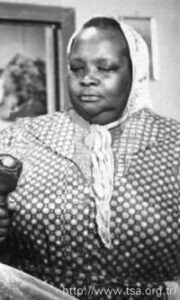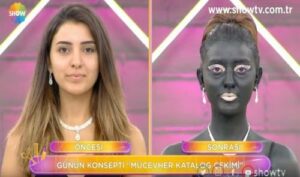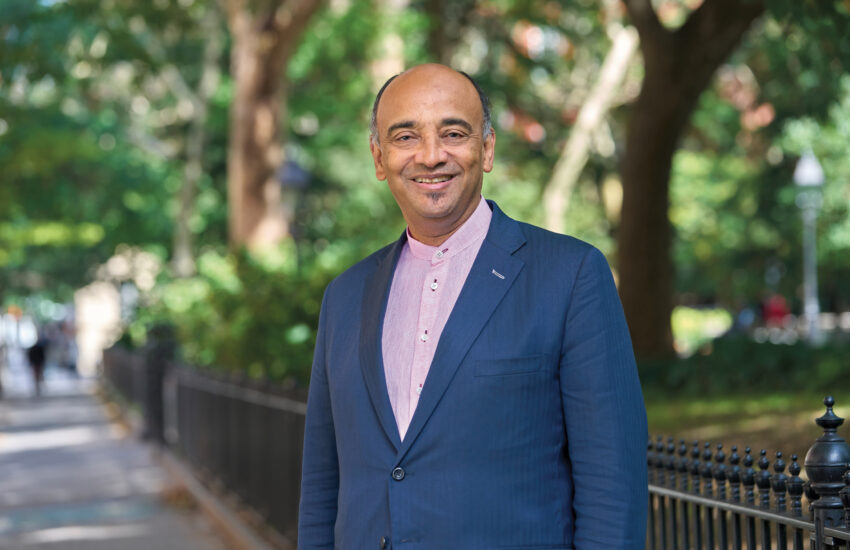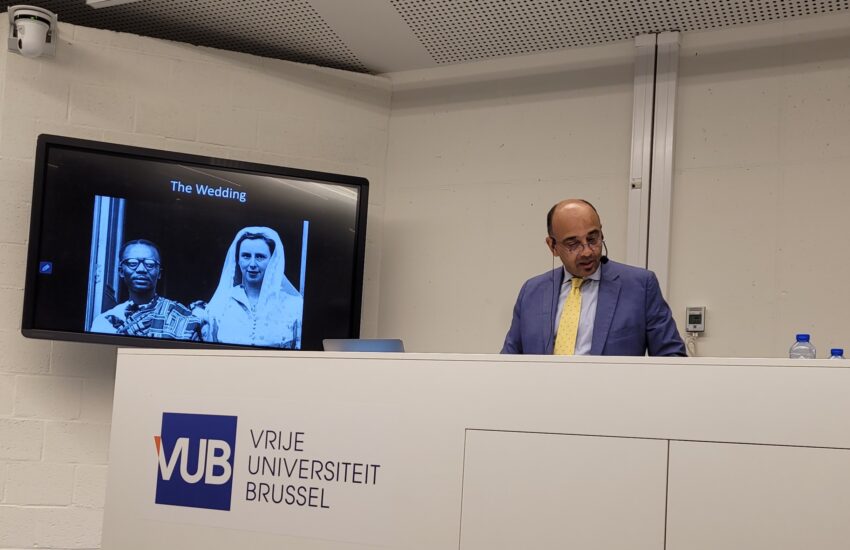Siyah: Anti-Black Racism in Turkish Popular Culture: Arab Mammies, Yam-Yams, and Sexualised Black Bodies
This is the seventeenth instalment in ‘Siyah’, a series which explores African Diaspora and Turkish social and cultural narratives, with journalist Adama Juldeh Munu. Tunay Altay took a closer look at the representation of Black people in Turkey’s media, past and present. The following is a condensed version of the original version entitled ‘Is there really no anti-Black racism in Turkey?’ for Bianet.org.
Tunay Altay is a PhD candidate in sociology at Humboldt University. His research and teaching focus on the issues of citizenship, migration, sexuality, and race. In his spare time, Tunay writes cultural commentaries about politics, art, and activism in Germany and Turkey. He is also involved in community organising for LGBTQ groups in Berlin.
* Content warning: Some of the references in this article involve racist and discriminatory images and videos and may cause emotional distress
From the Yeşilçam era (the 1950s – late 1970s) to contemporary culture, stereotypical figures in Turkey’s media provide a strong ideological justification for intersecting oppressions of race, class, gender, and sexuality.
Against this background, in this contribution, I focus on the brief moments of visibility and representation of Black people in Turkey’s popular culture, primarily in the media, and revisit some stereotypes that have shaped and restricted the imageries of (the) Black experience in Turkey’s ‘subconscious’.
The media produces images, concepts, and premises which “…provide the frameworks through which we represent, interpret, understand, and ‘make sense’ of our social existence” (Hall, 1981).
In this sense, I argue that anti-Black representations in Turkish media have functioned as controlling images (Hill Collins, 2009) which establish Black and racialised people as inferior and cloak racism and social injustice as ‘harmless’, ‘normal’ and even in some cases ‘comedic’.
The Arab Mammy and the Issue with Blackfacing
Assigning Black women household duties was a common practice in Ottoman Turkey (Özsoy, 2010). This practice continued until Ottoman Turkey’s late attempt at abolishing slavery at the end of the 1890s.
Connected to this history of slavery in Ottoman Turkey, the Arab mammy (Arap Bacı or Bacı Kalfa in Turkish) stereotype was one of the early representations of Black women during the Yeşilçam era. Arab mammies were usually depicted as older, religious, overweight women with heavy accents; always in a supportive role as caregivers for wealthy Turkish families.
Let’s look at Hulki Saner’s Gece Kuşu (1960) to understand the dynamics between the Arab mammy and the Turkish household. In the opening scene of the movie, we see Belgin Doruk, one of the most famous actresses in Turkey at the time, discussing a love affair with a servant, an Arab Mammy, while playing the piano. The piano and the Arab mammy both appear as symbols of Doruk’s socioeconomic background, objects that only amplify her storyline.
The objectification is so absolute that the Arab mammy is addressed in every scene only as dadı (nanny in English), given no name and no sign of individuality. The Arab mammy is played by Dursune Şirin (in the black-white picture on the right), a Black Turkish actress who only appears in filler scenes to perform physical and dialect comedy.
The strong comedic elements of Şirin’s character are at the core of the Arab mammy stereotype in Turkey’s early media, which confined Black women to the function of the obedient, naïve, and ‘comedic’ servant who has accepted her subordination within the Turkish household.
The Arab Mammy Character Revisited in the 2010s
Dursune Şirin took part in thirty-eight movies over her long acting career and mostly played nameless dadı characters. Nonetheless, not all Arab mammies in Turkey were played by Black actors, which leads us to the long tradition of blackface in the popular culture of Turkey.
Early cases of blackface in Turkey’s theatre might be connected to the country’s tradition of ethnic humour, which involves the exaggerated and highly stylised portrayal of Turkey’s various ethnic groups, including Armenian, Greek, Roma, Kurd, and Laz people. One of the most well-known examples is Tevfik Gelenbe, a non-Black Turkish actor who played Arab mammy characters throughout his career from the 1960s to the 1980s.
Gelenbe’s Arab mammy was an exaggeration of Şirin’s interpretation with a thicker accent, a larger and disproportionate body shape, colourful clothing, and stronger elements of physical comedy. In a way, Gelenbe turned the Arab mammy into a cringey lolcow, a figure who only exists to get laughs.
As Black people have withdrawn from predominantly non-Black Turkish households, the Arab mammy stereotype has lost its popularity and been turned instead into a historical figure that is still used as a ‘comedic’ gimmick to insult and make fun of Blackness.
In 1998, Ruhsar, a hugely popular TV series at the time, released an episode where a non-Black character is magically turned into an Arap Bacı (Arab mammy), complete with the sounds of African drums, as a punishment for getting in the way of a love affair. Finally, in 2013, Eti, a leading confectionary company in Turkey, revisited the Arab mammy character in a humiliating TV campaign by casting an actor in blackface who performed the Gelenbe tradition with exaggerated comedic elements.
The Yam-Yam and the Savage
In 1970, a highly popular movie series, Tourist Ömer, took its audience to Kenya in a sequel called Tourist Ömer is Among Cannibals (1970). The movie tells the story of Ömer, an adventurer from Turkey, heading to Kenya to mine diamonds. Inspired by examples of colonial, white-saviour cinema like Tarzan and Indiana Jones, the movie depicts a new and ‘exotic’ world, full of animals living in chaos, presenting an image of Africa as a tribal and uncivilised place. As the movie unfolds, we see Ömer being captured by a local tribe (Turkish actors in blackface) and nearly being cooked in an act of intended cannibalism. Not surprisingly, Ömer also finds himself entangled in a love affair and saves a light-skinned woman from the Black locals by recreating a Tarzan-Jane-like white hero romance.
Moving to the 1990s, either as a consequence of popular US cannibal movies or the misrepresentation of Africa in Turkey’s cinema, Nese Karaböcek, a famous arabesque singer in Turkey, released an album named Yam-Yam (Eng. cannibal), featuring several songs dedicated to the false representation of Africa including a song titled Maymun Suratlı (Eng. monkey face). In the music video for Yam-Yam, Karaböcek depicts a racist fantasy: a cannibalistic ceremony with African symbols and Black actors dancing around a boiler. Karaböcek’s attempt to build a figurative connection between Turkish “Yerim seni” (Eng. an expression of love which translates as “I want to eat you”) and cannibalism, and therefore Black people, fall short of succeeding in anything more than promoting Blackness as an exotic, uncivilised, and dangerous culture in Turkish pop.
Karaböcek’s video is only one of many similar examples in Turkish pop. Only two years after this album, another singer named Gülben Ergen casts a Black toddler in her music video for Yaramaz (Eng. naughty), which showcases an affectionate relationship between Ergen and the toddler. At first glance, the video seems okay. Yet quickly after the release, Gülben announced in an interview that they were “…first thinking of casting a monkey but couldn’t find one.”

Persistent Discursive Constructions of Racism
The connection between Blackness, ‘the African’, and ‘monkeys’ is made possible not solely because of Tourist Ömer’s racist journey, Karaböcek’s album or Ergen’s video, but due to historic and persistent discursive constructions of racism.
Ergen’s comment recalls a long history of colonial discourse in which Black people were metaphorically represented as monkeys. Grada Kilomba explains this connection as a “…discursive regime, a chain of words and images that by association become equivalent: African – Africa – jungle – wild – primitive – inferior – animal – monkey.”
These racist associations have normalised anti-Black racism and provided ideological justification for the oppression, objectification and belittlement of Black people in Turkey in the name of comedy and adventure.
Sexualised Black Bodies
In 2011, Seda Sayan, one of Turkey’s most popular day-time TV presenters, invited Ronnie Coleman, an award-winning Black American bodybuilder, on the show. In a twenty-minute feature, Seda Sayan and her other guest Muammer Ketenci caused a series of cringe-worthy moments with their overall ignorance and racist attitudes.
Sayan repeatedly interrupted Coleman’s attempts to talk, touched his body, and even made a ‘funny’ remark about how Coleman reminded her of ‘King Kong’. At one point, Sayan faces the audience and says in an exaggerated tone: “I love him, his warmth, look at his claws [referring to Coleman’s hands].” As we see Coleman silently trying to be a good guest, Sayan’s implications about his body reduce him to a ‘fetish object’.
In an absurd display, Muammer Ketenci invites Coleman to an arm wrestle. After his defeat, Ketenci calls Coleman öküz (a derogatory term referring to someone’s uncontrollable strength) and forces him to make a flattering comment about his wrestling performance, which Coleman does as a gesture of good showmanship.

Between Sayan’s comments about Coleman’s body and Ketenci’s unreasonable desire to defeat him in a show of strength, Sayan’s program demonstrates how closely desire and envy are interwoven when it comes to sexualised Black bodies in Turkey.
In one early example of the sexualised representation of Black bodies in the popular culture of Turkey, a scene from Metin Erksan’s Criminals are Among Us (1964) shows a Black man in his underwear silently dancing in the background while the main protagonist accuses his counterpart, both fully clothed, of having a Black lover. Racism emerges here in the Black man’s presentation as subjugated, naked, and irrational.
It is also possible to trace elements of hypersexualisation in the representation of Black football players in Turkey. One public example was pop singer Ebru Gündeş’s hit single Sen Allah’in Bir Lutfusun (Eng. “You are the blessing of God”). In the video, Gündeş appears alongside Uche Okechukwu, a famous Black football player in Turkey’s Fenerbahce, in several romantic scenes. The video caused a day’s-long discussion in the media of the ‘strange’ couple and attracted racist comments about the Black penis and other racial fantasies about the Black male body.
How to Have a Long-Awaited Conversation?
These stereotypes are among the many images that normalise intersecting oppressions of race, class, gender, and sexuality in Turkey. Taken together, we can see that elements of comedy, adventure, and desire are used to sugar-coat anti-Blackness as ‘harmless’ and ‘comedic’ rather than what it is: racism.
There are, of course, some exceptional Turkish Black celebrities who have played an essential role in telling stories that do not simply fit into one or another restrictive image. Among these, are the well-known figures Esmeray, Mansur Ark, and Defne Joy Foster. Yet, their singular cases have not stimulated a wider conversation on anti-Blackness in Turkey.
The lack of conversation is also connected to the culture of denial in Turkey on issues of race. Aside from the country’s political fractions, which are themselves built on racist and nationalist ideologies, Yanık’s comments about the racism of Turkish democrats might be derived from ‘racial phobia’: the refusal to acknowledge the existence of systemic and everyday racism. Racial phobia is deeply entrenched in Turkish public discourse, where talking about racism is usually targeted as promoting ‘ethnic divisiveness’ or ‘ethnic propaganda’.

It is clear that “we love our Black mammies” cannot obscure the fact that Turkey has a serious problem with anti-Black racism and racism towards other racialised communities in Turkey. The later we postpone the conversation on anti-Blackness and the seriousness of racism in Turkey, the more we see celebrities using the N*word (see Ben Fero), posing in blackface (see Kuşum Aydın), and promoting blackfacing as a ‘trend’ in reality shows.
Instead of simply paying lip service to BLM and condemning anti-Black racism in the United States, the conversation that has emerged in Turkey should encourage us to educate ourselves about Turkey’s own history with racism, genocide, and violence, and to support local groups voicing their experiences with racism without the fear of being dehumanised, mocked, or objectified.
Here is a link to learn more about Afro-Turks: Afro-Turk Association / http://www.afroturc.org/
References
Bridges, George, Rosalind Brunt, and Communist University of London, eds. Silver Linings: Some Strategies for the Eighties: 12th Annual Meeting: Papers. London: Lawrence and Wishart, 1981.
Hall, Stuart, and Open University, eds. Representation: Cultural Representations and Signifying Practices. Culture, Media, and Identities. London; Thousand Oaks, Calif: Sage in association with the Open University, 1997.
Hill Collins, Patricia. Black Feminist Thought: Knowledge, Consciousness, and the Politics of Empowerment. 2nd ed. Routledge Classics. New York: Routledge, 2009.
Kilomba, Grada. Plantation Memories: Episodes of Everyday Racism. Münster: UNRAST-Verlag, 2019.
Özsoy, Ruziye. “XIX. Y.Y. Da Osmanlı’da Köle Ticareti Esirciler ve Zenci Köleler.” Erciyes Üniversitesi Sosyal Bilimler Enstitüsü, 2010.


